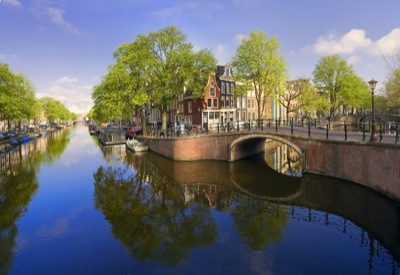
Photo by Sandra Raccanello
Amsterdam was made for walking.
With narrow streets, scenic canals and dozens of great museums, this Dutch city seems perfectly suited for pedestrians. Although other European destinations boast large iconic structures — the Eiffel Tower, Windsor Castle and the like — Amsterdam’s greatest attraction is the city itself.
Windshield tours do not do it justice, and there are no quick photo ops. The best way to experience the city is to walk alongside its canals, over its bridges, through its flower markets and amidst its locals. And as you move from van Gogh’s art museum to Anne Frank’s historic house, take your time, because strolling from one Amsterdam site to the next is the best part of the trip.
I got to know this great city from street level as a guest of Monograms, one of the tour options offered by the Globus family of brands. As with all Monograms packages, my visit started with a half-day orientation tour, followed by three days of free time to explore the city at my leisure.
Along the way, I reveled in the area’s art and history, discovered the magnificent Dutch pancake and found the soul of Amsterdam on its sidewalks.
Cruising the canals
“Sometimes they call us the Venice of the North.”
Leon Spit, Monograms’ local guide in Amsterdam, gave our group of a dozen or so visitors the lay of the land from aboard a boat as we toured the city via its canals. Some 165 canals crisscross the heart of the city; they are spanned by more than 1,280 bridges.
“Amsterdam was built over a peat bog, and so the canals were created for only one reason — drainage,” he said. “Later, we started using them for transportation. Some of the canals are two feet below sea level, so 50 percent of the city would disappear without dikes and dunes here to protect us.”
Utilitarian though they may be, the canals have created a singular charm in Amsterdam. Almost anywhere you go in the central part of the city, you find yourself walking alongside one of the canals, which often flow between the two sides of small streets.
The city boasts more than 6,800 historic buildings, built in the 16th to the 18th centuries, and the facades of those beautiful structures reflect in the dark canal waters to create one-of-a-kind streetscapes.
The abundance of canals also gave rise to another Amsterdam specialty: Today, more than 2,500 houseboats line the waterways, connected to the city’s power and sewage grids and providing permanent — and popular — housing for thousands of residents.
“After World War II was over, a lot of people wanted to move to Amsterdam, but they couldn’t find apartments,” Spit said. “So they bought boats and began to live on them. Today it’s really popular to live on a boat. When people sell them now, they can ask anything they want. The average boat sells for 350,000 euros.”









